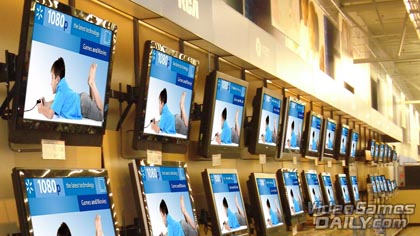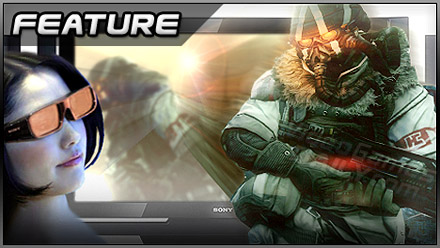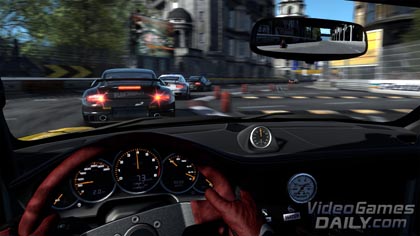Our understanding of what 3D can bring to videogames is still a partial one, like Kim Kardashian’s wardrobe. Thanks to E3 and its ranks of kitted-out booths, pundits have seen enough of the technology in action to grasp a few of the possible advantages – better object ‘pop’, heightened immersion – and disadvantages – reduced brightness, disorientation – but until the bulk of consumers get their hands on the requisite boxes, cables and headsets, much of the discussion will remain academic.
Sony and Nintendo, of course, would like us to feel that 3D’s contribution is nothing short of revolutionary already. Having Trojan-Horsed the Blu-ray media format into PlayStation households, Sony is looking to repeat the trick with its next generation of high-definition displays: hot upcoming gaming properties like Killzone 3 and Motorstorm: Apocalypse are justifications as much for 3D Bravia tellies as for PS3′s 10 year lifecycle. Nintendo, meanwhile, is pursuing new conceptual frontiers in on-the-go entertainment with its ‘glassless 3D’ handheld.
Whether 3D will be a commercial success is a separate, and perhaps easier to answer, question. There are obstacles to uptake: the spectre of Nintendo’s first foray into 3D gaming, scrapped after a year at market, lingers over the razzle-dazzle of its present-day efforts, and the expense of living-room 3D floats well above any ‘magic number’ price tags the world’s market research groups might care to assign. But RRPs will drop as the hardware matures, and the sad legacy of Virtual Boy is more than counter-balanced by the range of manufacturers and publishers - both within and without the games industry - now massed behind 3D’s standard.
According to Greg Donovan, Producer at celebrated Red Faction developer Volition Inc, history is in the process of repeating itself. “I think it’s inevitable that 3D gaming will become a staple feature,” Donovan told us in a recent chat. “It’s a matter of ‘when’ and not ‘if’, but I wouldn’t speculate on a timeframe.

Volition's Greg Donovan thinks 3D will catch on after everyone has finished fussing about it, same as other recent tech like HDTV
“In my opinion there’s an obvious recurring ‘arms race’ here - new technology is established and there are some early development adopters, followed by much speculation regarding installed bases, consumer acceptance, which first party will emerge as the clear front-runner and, of course, technological limitations. And then usually said technology is a staple in a matter of years. A similar pattern occurred with the emergence of HDTV’s and HD gaming.”
Third party studios like Volition will play a key role – perhaps the key role – in ensuring (or not) that this growth has a foundation in compelling experiences, that the surge owes as much to great gaming as carpet-bomb publicity campaigns, sneaky product integration and the glitzy attractions of 3D media at large. Lacking the dedicated resources and artificial loyalties of their first-party brethren, these are the companies who will truly put 3D gaming to the test.
The auto-fetishists at Slightly Mad Studios, a London-based independent, are in a uniquely strong position to comment: SHIFT, the developer’s well-received revamp of the ailing Need for Speed franchise, is notable for its use of depth as a mechanical cue, with HUDs that possess their own inertia and a carefully judged blurring or sharpening of foreground and background to simulate the behaviour of a driver’s lenses. This (more or less unparalleled) feel for the space surrounding the player’s perspective seems a natural fit for 3D, and write-ups of the PC version’s not-much-trumpeted support for nVidia’s 3D Vision cards have been positive.
SHIFT’s Design Lead Andy Tudor was ‘astounded’ by the functionality during development. “The additional depth perception and sense of speed that we were already simulating using traditional 2D techniques now were given that additional ‘zing’ in 3D. In cockpit camera for example, it was far easier for your mind to comprehend the spatial distance of objects around you – the driver’s hands, the steering wheel, the cockpit, gauges, the environment immediately surrounding the vehicle, and the world beyond.
“When you then factor in the scenery whipping past you at over 200 mph and the simulation of G-forces we included in the heads-up display, the additional z-depth data that was being sent to your brain heightened the overall sense of immersion of being ‘in the driver’s seat’, making it more exciting and visceral. It’s one of those experiences that once you’d tried it for yourself, you don’t want to go back.”
If 3D cuts the mustard here, it’s worth remembering that SHIFT is a fairly specialised addition to the already specialised sub-genre of the realistic racing sim. Not every 3D game will be constructed to so amenable a body of gameplay criteria, and in some cases the greater visual complexity may prove more hindersome than helpful.
Given the hullabaloo Sony is kicking up over Killzone 3, it’s startling to hear another shooter developer, Zombie Studios, opine that the shooter and 3D are a problematic pairing.







 Satoru Iwata Video Interview - the late Nintendo president spoke with Kikizo in 2004 as 'Nintendo Revolution' loomed.
Satoru Iwata Video Interview - the late Nintendo president spoke with Kikizo in 2004 as 'Nintendo Revolution' loomed. Kaz Hirai Video Interview - the first of Kikizo's interviews with the man who went on to become global head of Sony.
Kaz Hirai Video Interview - the first of Kikizo's interviews with the man who went on to become global head of Sony. Ed Fries Video Interview - one of Xbox's founders discusses an epic journey from Excel to Xbox.
Ed Fries Video Interview - one of Xbox's founders discusses an epic journey from Excel to Xbox. Yu Suzuki, the Kikizo Interview - we spend time with one of gaming's most revered creators.
Yu Suzuki, the Kikizo Interview - we spend time with one of gaming's most revered creators. Tetris - The Making of an Icon: Alexey Pajitnov and Henk Rogers reveal the fascinating story behind Tetris
Tetris - The Making of an Icon: Alexey Pajitnov and Henk Rogers reveal the fascinating story behind Tetris Rare founders, Chris and Tim Stamper - their only interview? Genuinely 'rare' sit down with founders of the legendary studio.
Rare founders, Chris and Tim Stamper - their only interview? Genuinely 'rare' sit down with founders of the legendary studio. The History of First-Person Shooters - a retrospective, from Maze War to Modern Warfare
The History of First-Person Shooters - a retrospective, from Maze War to Modern Warfare
3-D Gaming is going to be off the wall… I cannot wait! Hopefully it won’t be too expensive
I’m ready to go for 3D Gaming!! I can’t wait for all the possibility’s!
There are a couple Xbox 360 Indie games that have been out for a while that support 3D with the two toned glasses.